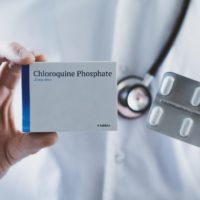
BartekSzewczyk/iStock(NEW YORK) — If drugs can be famous, chloroquine is as close as it comes.
Chloroquine, and its derivative hydroxychloroquine, were touted by President Donald Trump as potential “game changers” when combined with azithromycin, and were elevated to stardom practically overnight. Previously approved as anti-malarial drugs, for systemic lupus erythematosus and rheumatoid arthritis, these drugs are now used by some front line clinicians “off-label” for their patients with severe illness from COVID-19.
The “off-label” use means the medications have not been adequately tested or approved for that specific disease or illness. So why would clinicians risk it and why would politicians prematurely praise it?
For now, there is no approved treatment, vaccine or cure for COVID-19. With confirmed cases of COVID-19 surpassing the half a million mark worldwide, clinicians all around the world are learning from each other’s experiences and drug cocktails, trying to give their patients the best chance they can.
Dr. Michael J. Ackerman, Mayo Clinic genetic cardiologist and director of the Mayo Clinic Windland Smith Rice Comprehensive Sudden Cardiac Death Program, explains that one of his colleagues described the consequences of using medications “off-label” for COVID-19 as “friendly fire.”
They throw everything at it and hope the benefits outweigh the risks. However, Ackerman explains that it may have led to the Wild West, where “drugs are being used without proven therapeutic efficacy- based on hope and promise.” He says he does believe they may work, but emphasizes the need for “rational, careful, prudent guidance.”
Guidance is particularly paramount for chloroquine and hydroxychloroquine because of a known side effect: drug-induced arrhythmias from prolonged QTc intervals that can be detected by echocardiogram. In rare cases, your heart can stop and you can die.
“How do we navigate while we’re waiting for clarity on the drug’s therapeutic efficacy? How do we respect this unwanted side effect, which happens to not just be lightheadedness, dizziness and tingling fingers, but sudden death?” said Ackerman.
To answer these questions, Ackerman and his colleagues set out to create a clinical algorithm to help determine each patient’s risk.
The risk categories they developed put people into three groups, simplified as ‘green light’ for low risk, ‘yellow light’ for moderate risk, and ‘red light’ for high risk. Having a high risk for drug-induced arrhythmias doesn’t automatically mean you shouldn’t take chloroquine and hydroxychloroquine. But it does mean that your doctor should carefully weigh the risks versus the potential benefits.
“If we know their QTc, they are going to be ‘green light,’ go! There is going to be tremendous safety margin with these medications for 90% of the patients,” said Ackerman.
“For 5 to 10%, they’re going to be in a caution light, a ‘yellow light’ because they are already showing that they’re kind of on the high edge of normal of the QTc even before we add these medications, and for 1% they’re going to already be at the ‘red light,’ be very, very careful. The risk-benefit balance better be there, and if we still think we should proceed, we better do what we would call our QT sudden cardiac death countermeasures preemptively,” he said.
If the patient needs the medications, there are ways to reduce the risks such as correcting electrolyte abnormalities, discontinuing other medications that could cause problems if taken at the same time as hydroxychloroquine, keeping patients on heart monitors, or asking them to wear an external defibrillator.
Ackerman fully expects the use of hydroxychloroquine to skyrocket. In fact, there are already reports of patients who take the drug for its other approved purposes, such as rheumatoid arthritis, not being able to get their medication at the pharmacy.
If these medications get approved for COVID-19, “we’re going to be seeing hundreds and hundreds of thousands of people, potentially millions being put on these medications. When you scale it up to that level, this unwanted side effect which happens to be a big deal is going to show itself, and it’s going to show itself in a significant way,” Ackerman said.
Ackerman thinks that the best initial defense is turning the QTc value into a global vital sign.
“Just like a diabetic needs to know or does know his or her glucose, this QTc value is essentially a vital sign,” he said.
Knowing your QTc interval is not only important for COVID-19 treatment, but also because of countless other medications that exist.
“This isn’t the only scenario where the medication inadvertently, suddenly killed the patient because of drug-induced long QT syndrome and drug-induced sudden cardiac death,” Ackerman said.
In fact, he points out that “the single most common reason why a drug gets removed from development or market is drug-induced sudden cardiac death because of drug-induced long QT syndrome.”
QTc is undoubtedly an important way to screen patients with COVID-19 who might be good candidates for the experimental hydroxychloroquine, but this may pose a challenge. Administering an ECG to patients with COVID-19 would mean a technician would risk exposure and use precious personal protective equipment for each ECG that was needed, according to Ackerman.
For now, by not screening patients with COVID-19 before starting these medications, doctors are effectively shooting in the dark.
Fortunately, the Food and Drug Administration approved a personal ECG device that would allow accurate ECG recordings (and therefore QTc calculations) to be taken by patients on their smartphones without potentially exposing a technician to COVID-19 multiple times.
By understanding everything about a patient, their risk factors, their medications, their vital signs — in this case their QTc interval — doctors can use the model to pinpoint a patient’s risks versus benefits, and treat them with more accuracy. Broadly speaking, doctors refer to this concept as “precision medicine,” meaning they try to tailor each treatment to make it unique for each patient.
Ackerman, who has spent the last 20 years of his career focused on patients with congenital prolonged QT, believes “that this is the time to really put precision medicine into action. It has been a buzz phrase for too long. And now I think we’ll see how well can actually do this. We know our patient’s profile, we know the drug’s profile, we try to see if we can match that and really do precision medicine. I think we can. I mean, we should be able to. We have the knowledge, we have the technology, we have the ability.”
Copyright © 2020, ABC Audio. All rights reserved.















